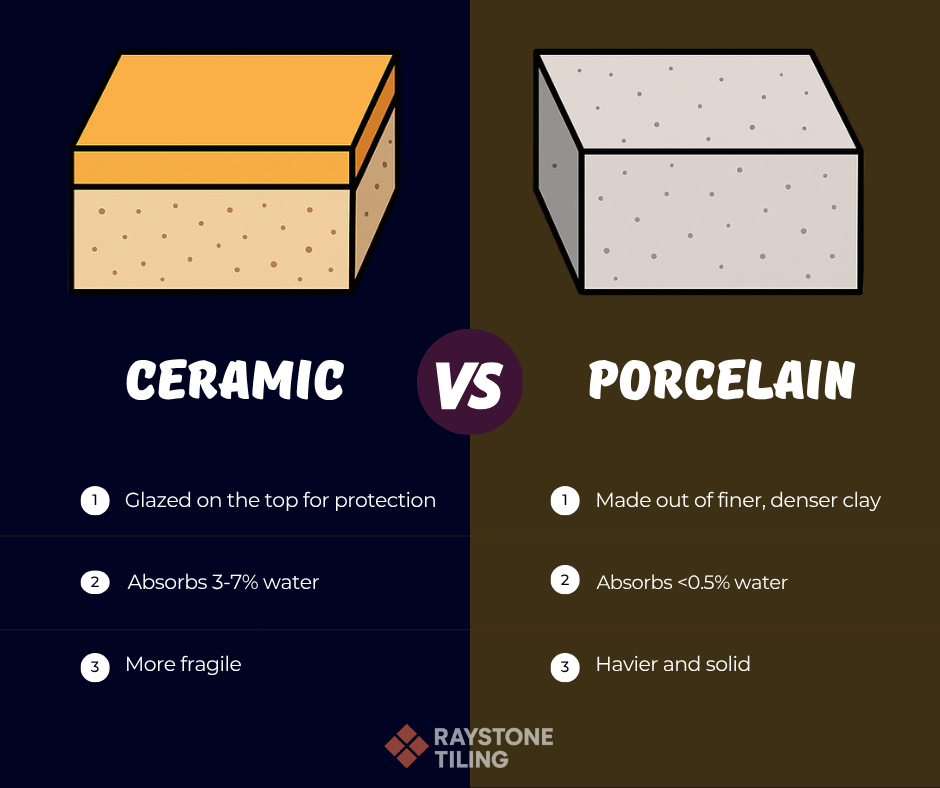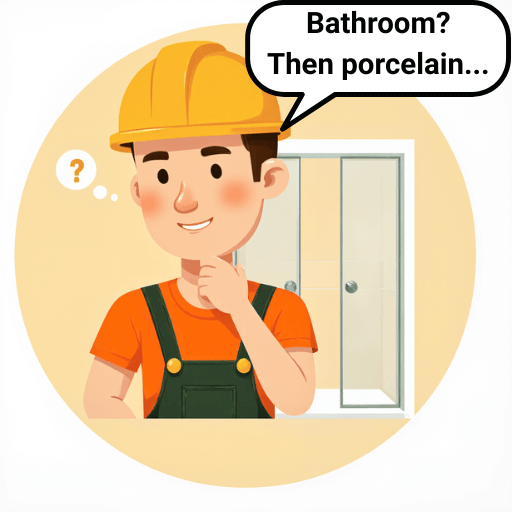Porcelain vs. Ceramic Choosing the Right Option for Your Home
Guide - wish I had as a beginner Tiler! 


1. What Are Ceramic and Porcelain Tiles?
Porcelain is made from dense clay and fired in higher temperatures ovens, making it much harder and dense structure.
Process of creating ceramic tiles is the same, but they’re made from less dense clay and burned at lower temperatures, making them more fragile than porcelain. That also is the reason why they need to glazed on the top to create additional barrier.

2. When should you use ceramic and when porcelain?
Ceramic: Room walls, splashbacks
Porcelain: Use it for high-traffic areas in your home, rooms with a lot of moisture, patios and outside areas.
| Area / Location | Best tile |
|---|---|
| Indoor walls (living room, hallway) | Ceramic |
| Kitchen splashback / backsplash | Ceramic |
| Shower floors / wet-room floors | Porcelain |
| Bathroom floors and walls | Porcelain |
| Kitchen floors (high spill / traffic) | Porcelain |
| Living room & bedroom floors (indoor, low-moisture) | Porcelain |
| Outdoor areas (patio, path, balcony) | Porcelain (Vitrified) |
| Low-traffic decorative surfaces (feature walls) | Ceramic |
| Garage or very high-impact commercial floors | Porcelain / Vitrified |
Learn about the differences between porcelain and vitrified tiles here.

3. Cost and Tiling Experience
As a tiler I have to say that ceramic tiles are easier to install. However, porcelain in my opinion looks better due to that heavy look. Very durable and resistant to chipping during cutting. With porcelain you will need a good wet saw and angle grinder to deal with some of the cuts that are required.

| Tile Type | Approx. Cost (UK) | Notes |
|---|---|---|
| Ceramic Tiles | £10 – £40 per m² | Cheaper, widely available, easier to cut and install but edges chip more during cutting. |
| Porcelain Tiles | £25 – £70 per m² | More durable and water-resistant, higher cost due to density and production. More resistant to chipping when cutting. |
How to fix problem of chipping ceramic tiles?
Uneven edges can be levelled and refined after cutting with diamond polishing pads grit 100 - 200.
Happy Tiling!

Frequently Asked Questions — Porcelain & Ceramic Tiles
Which tile is cheaper, ceramic or porcelain?
Ceramic tiles are more affordable and budget-friendly option. Porcelain is more expensive due to it’s higher density and more costly production process.
Which tile is easier to cut and install?
Ceramic tiles are easier for tilers to install. Porcelain requires wet saw, angle grinder and skilled hand. Be careful with cutting porcelain, you must wear PPE, due to it’s very sharp edges. Also, you should be aware of excess vibrations when using angle grinder with porcelain and mitigate that.
Which tile chips more during cutting?
Ceramic tiles chip more during cutting. Porcelain is more durable so can handle more force.
When should I choose ceramic over porcelain?
Choose ceramic for low-traffic areas, room walls, low moisture areas, kitchen splashbacks, DIY projects, tile training, or where lower cost of materials matters to you.
When should I choose porcelain over ceramic?
High traffic floors, commercial areas, outdoors, wet rooms, where durability and water resistance are essential to you. Learn about the difference between normal porcelain and vitrified porcelain and which one to use.
Need a Quote?
Professional tiling services in — Tamworth, Lichfield, Sutton Coldfield, Nuneaton. New kitchens splashbacks, bathrooms & floor.
Friendly advice and no-obligation quotes.

